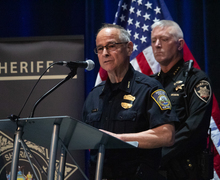Officials discuss training measures taken in case of on-campus shooting situation
Logan Reidsma | Photo Editor
Less than 53 hours after the email from Student Association President Aysha Seedat regarding on-campus shooter preparations was sent to the SU community, a 15-year-old male was killed on his porch and a 17-year-old male was shot in the leg on Hope Avenue, about two miles from the SU campus.
In the event that there is an active shooter on campus, the Department of Public Safety’s estimated response time is 60 seconds, which leaves students 60 seconds to protect themselves.
In light of recent college shootings around the country, including those at Oregon’s Umpqua Community College and at Northern Arizona University, Student Association President Aysha Seedat said Syracuse University students were approaching her in classes and asking a heavy question: “Do you think the university’s prepared?”
It was a question Seedat had asked Chief Law Enforcement Officer Tony Callisto, and his answer included DPS’s minute-long response time. Seedat said her biggest concern before meeting with Callisto was spreading a message of calm to students since a lot of them might have been freaking out.
“So kind of just calm the people saying, ‘we’re prepared,’ but in that first minute what you do is absolutely crucial,” Seedat said.
DPS sent out an Orange Alert last Wednesday evening after suspects in a murder that took place on Hope Avenue that night fled through Oakwood Cemetery near campus. Though there has never been a shooting on the SU campus, DPS conducts training with its officers using their guns, and holds training every other year for dealing with a campus shooter.
DPS Chief Bobby Maldonado said in an email the department’s protocol in the event of an active shooter is to generally dispatch officers directly to the threat and attempt to terminate the threat as soon as possible. If the whereabouts of the threat is unknown, DPS would dispatch officers to areas where it believes the threat exists.
Maldonado added that every situation is different and presents unique challenges, and that the ability of DPS to dispatch armed officers toward an active shooter is significant. Out of DPS’s 42 total public safety officers, 36 are armed, as of August.
Seedat and other SU leaders sent an email to the entirety of SU’s student body on Oct. 12 detailing what students should do in the event they are in a building where a shooting is occurring — in short, “get out, hide out, strike out.”
If they are able to, students should get out of the building, let others in the building know that they need to leave too and call DPS once away from danger, according to Seedat’s email. If students can’t get out, they should hide out in a room away from windows and lock or block the door. In the event that a shooter enters the room and the student cannot hide, they should “strike out” at the shooter by throwing items or, if possible, tackling the shooter to try to disarm them.
Less than 53 hours after the email was sent to the SU community, a 15-year-old male was killed on his porch and a 17-year-old male was shot in the leg on Hope Avenue, about two miles from the SU campus. The SU and State University of New York College of Environmental Science and Forestry campuses subsequently went into a “shelter-in-place” mode, in which an Orange Alert was activated for a criminal occurrence for the first time since November 2008. Students were advised to stay indoors.
Seedat, a senior policy studies major, said she has met with DPS more than five times since the semester began, and SA has a DPS Safety Committee that meets on a monthly basis to discuss the safety concerns of students.
“I think a lot of students trust that judgment that when the Orange Alert did go off it’s like, ‘OK, this is serious. I should probably listen to it and stay indoors,’” she said.
Seedat said she and SA Vice President Jane Hong are planning on reaching out to DPS to discuss issues of communication between DPS and students during Wednesday’s alert. Seedat said there were Residential Security Aides (RSAs) who were confused about whether or not they should let students in and out of residence halls. Student workers in Archbold Gymnasium also let students out before the alert had been lifted, Seedat said.
Seedat suggested other student workers — not just resident advisers — go through training for situations like these.
In regards to DPS officers receiving training in the case of an active shooter, Maldonado said officers receive training twice a year during in service firearm training. Every other year, DPS conducts specific active shooter training, he added.
Seedat said she hopes students will become more cognizant about the reality of life in the city of Syracuse and understand that life doesn’t end at Comstock Avenue or Marshall Street.
“I think that when people hear about what had happened — a 15-year-old teenager passed away and a 17-year-old went to the hospital — I think a lot of students kind of realize that the city of Syracuse is very different when you’re ‘off the hill,’” she said.
Published on October 18, 2015 at 10:34 pm
Contact Alexa: [email protected]




